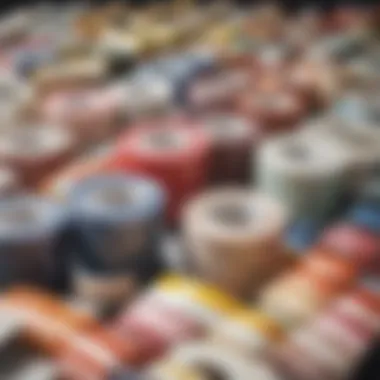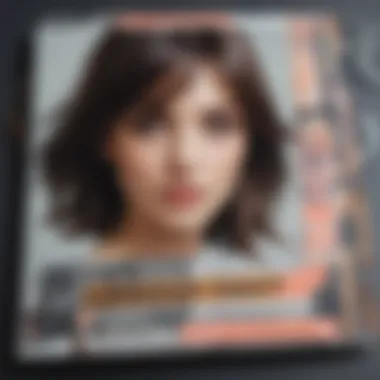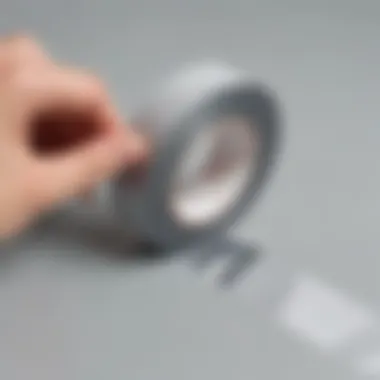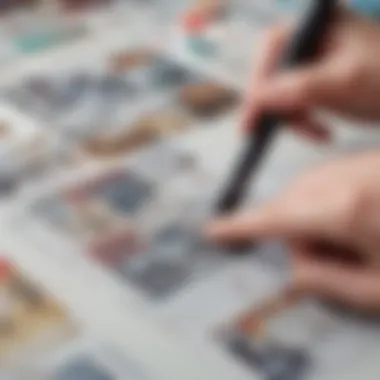Maximizing Creativity with Double-Sided Tape in Scrapbooking


Intro
When it comes to scrapbooking, the designs, colors, and themes take center stage. However, the backbone of any beautiful scrapbook lies in the tools used. One often overlooked but crucial element is double-sided adhesive tape. Its ability to securely attach various materials while remaining hidden makes it a favorite among avid crafters. This resource will illuminate the multifaceted roles that double-sided adhesive tape plays in enhancing scrapbooking projects, offering insights, techniques, and guidance for all skill levels.
Double-sided adhesive tape comes in a variety of formats - some are incredibly thin, making them perfect for delicate work, while others are stronger and better suited for heavier embellishments. Navigating this diverse world can be overwhelming, especially for those just starting their crafting journeys. Fear not, this guide is here to help both novices and seasoned scrapbookers unlock the wonders of this adhesive marvel.
In the sections to follow, we will explore the different types of double-sided adhesive tapes, their specific applications, and crucial tips for maximizing their benefits. Whether you're layering patterns or securing photos, this comprehensive overview is designed to elevate your craft to new heights.
Understanding Double-Sided Adhesive Tape
When it comes to scrapbooking, having the right tools and materials can take your creativity to a whole new level. Double-sided adhesive tape is one of those essential items that many crafters keep within arm's reach. This tape serves not only as a practical method for sticking items together but also opens up an avenue for more intricate designs and layouts.
Understanding double-sided adhesive tape is crucial for a couple of reasons. Firstly, it provides a clean and polished finish to your projects. Unlike traditional glues that can leave visible marks or mess, double-sided tape adheres materials together but remains largely inconspicuous. This quality allows for a seamless integration of photos, embellishments, and paper without the distraction of adhesives peeking through. Moreover, the ability to place adhesive on both sides allows for creative flexibility in your designs, letting you manipulate elements with greater ease.
Crafting with double-sided tape brings with it some definitive advantages. For starters, this tape typically comes in various widths and strengths, enabling artists to choose the perfect fit for their specific needs. Some tapes are crafted for lightweight papers, while others are ideal for heavier materials like cardstock or chipboard. It’s worth noting that the choice of tape can significantly affect the quality and durability of your scrapbook.
In this section, we’ll break down what exactly double-sided adhesive tape is made of and how it compares to other adhesive options commonly used in scrapbooking. Doing so will arm you with the knowledge needed to make informed decisions as you tackle your next crafting project.
Definition and Composition
Double-sided adhesive tape is essentially a roll of tape that has adhesive on both of its sides. Designed for strong and reliable performance, the tape is usually made from a thin film or plastic coated with an adhesive substance. This sticky nature encapsulates it as a versatile tool in various applications, but its role in scrapbooking is particularly noteworthy. It can range from very thin options used for delicate materials to thicker versions that can hold larger items securely.
Composition wise, the majority of double-sided tapes are produced with acrylic or rubber-based adhesives, each offering different qualities in terms of stickiness and longevity. The quality of the adhesive directly impacts how well the tape will hold up over time, which is especially critical for preserving your scrapbooks.
Comparison with Other Adhesives
Understanding how double-sided tape stacks up against other adhesive options is important. Traditional glue, for instance, can be messy and time-consuming, requiring careful application and often resulting in longer drying times. In comparison, double-sided tape offers instant adhesion, allowing for immediate handling of the materials involved without waiting around.
Here’s a quick look at how double-sided adhesive tape compares to other adhesive types:
- Glue Sticks:
- Wet Adhesives:
- Mechanical options, like mounting squares:
- Clean application but may not be as strong; can dry out over time.
- Often provide a stronger bond, but the drying time can delay your process.
- Offered in predefined sizes; may limit creative flexibility.
Types of Double-Sided Adhesive Tape
When it comes to scrapbooking, not all double-sided adhesive tapes are created equal. Understanding the different types available is crucial for a successful project. Each tape type boasts unique features, offering distinct advantages that cater to various applications and materials. Therefore, selecting the right type can greatly enhance your creative process, providing the flexibility and control you need to bring your vision to life.
Paper Tape
Paper tape is a fundamental choice for many scrapbookers due to its lightweight and easy-to-use characteristics. Made from a thin paper material, this tape has a gentle adhesive that allows for repositioning, making it ideal for beginners. It adheres well to paper and light materials, ensuring a reliable bond without causing damage.
Some advantages include:
- Ease of Use: Ideal for quick applications without much fuss.
- Repositionable: The gentle adhesive means you can adjust placements without tearing your scrapbook.
- Cost-Effective: Paper tape is often more budget-friendly, allowing you to stock up without breaking the bank.
However, it may not be suitable for heavier materials or projects requiring extra durability.
Foam Tape
Foam tape, on the other hand, takes dimensionality to a new level in scrapbooking. This tape is thicker than paper tape, creating a space between layers, which brings a compelling 3D effect to your designs. It’s particularly valuable for photo mounting or when trying to create depth in layouts.
Key benefits of foam tape include:
- Added Dimension: Elevates elements for a striking aesthetic.
- Strong Adhesion: Perfect for heavier embellishments that need a secure hold.
- Versatility: Works well on various surfaces including cards, frames, or even mixed media artworks.
While it provides excellent support, careful use is advised in order to ensure balance in the overall design.
Clear Tape
Clear tape is often favored for its virtually invisible application, ensuring that the focus remains on your artwork, not the adhesive. This type of tape is perfect for those who want a seamless look when adhering photos or embellishments.
Consider these points:
- Invisible Finish: Ideal for clean layouts where the adhesive should be unnoticeable.
- Suitable for Various Materials: Works well on paper, plastic, and even some fabrics.
- Durable Bond: Clear tape provides reliable adhesion without compromising the aesthetic.
However, one downside to consider is that clear tape can sometimes be tricky to handle, as it tends to tear easily if too much pressure is applied.


Fabric Tape
Finally, fabric tape serves a unique purpose in the world of scrapbooking, adding an element of texture and color to your projects. Made from cloth, this tape is perfect for those wanting to add softer elements to their designs, offering a creative twist.
Here are the highlights:
- Textural Variety: Enhances visual interest and tactile experience.
- Colorful Options: Often available in various patterns and colors, making it appealing for thematic projects.
- Flexible Use: Works well with fabric elements in scrapbooking layouts.
However, fabric tape may not provide the same level of adhesion on non-fabric surfaces, so it’s best used in conjunction with other adhesives on paper.
In summary, selecting the right double-sided adhesive tape is as important as choosing the right photos and embellishments for your scrapbook project. The different types bring unique capabilities and benefits, so consider your specific needs before diving into your craft.
By choosing the right tape, scrapbookers can maximize creativity while ensuring their projects are both lovely and durable.
Advantages of Using Double-Sided Adhesive Tape
When it comes to scrapbooking, every little detail can make a significant impact on the final presentation. Double-sided adhesive tape is a versatile tool that can elevate your scrapbooking game in numerous ways. Whether you are a novice just learning the ropes or a seasoned scrapbooking aficionado, understanding the advantages of this particular tape can enhance your creative process and results. Let's dig deeper into a few key advantages that make this tape indispensable for scrapbook enthusiasts.
Seamless Finishing
A major feature of double-sided adhesive tape is its ability to create clean, seamless finishes. Unlike conventional glue or one-sided tapes, double-sided tape adheres text, images, and embellishments flat against the surface without leaving unsightly residue. This is particularly beneficial when layering materials, as it allows for a polished look that feels effortless. By eliminating the visibility of glue lines, your scrapbook pages can take on a more professional appearance.
For example, when working on a photo collage, using double-sided tape ensures no bulky edges protrude, allowing your images to flow together beautifully. In essence, the seamless finish enables anticipated aesthetics that captivate attention, providing a vital competitive edge when showcasing your work in community gatherings or social media.
Versatility in Application
Double-sided adhesive tape boasts remarkable versatility. Unlike some adhesives which may work best with a particular type of material, double-sided tape easily bonds to paper, cardstock, fabric, and even lighter embellishments. This means that you can seamlessly integrate various materials into your scrapbook, from floral designs to textured papers and beyond.
Here’s a quick look at how this versatility manifests:
- Layering: Various weights of materials can be stacked without compromising strength or aesthetics.
- Mixed Media Projects: Perfect for when creativity knows no bounds, allowing scrapbookers to experiment with different textures.
- Interactive Elements: Use it to secure flaps, pockets, or pull-out tabs for a fun twist.
The ability to apply this tape on diverse materials opens up a world of creative possibilities; you can enhance your scrapbook with different textures and layers without fearing that items will fall off or wrinkly.
Precision in Placement
Precision is the name of the game in the world of scrapbooking. One of the standout benefits of double-sided adhesive tape is how simple it is to achieve an exact placement of every element on your page. With its easy-to-use design, you can adjust pieces as needed before securing them permanently. This is ideal for intricate layouts where every detail counts.
The tape's structure allows for a controllable application, allowing you to:
- Avoid Mess: No drips or spills to concern yourself about.
- Control Dimensions: Ensuring every component is perfectly aligned.
- Easily Replace Elements: If something isn’t quite right, simply peel it up without tearing your paper.
In a nutshell, double-sided adhesive tape arms scrapbookers with the ability to precisely position elements, resulting in enhanced craftsmanship and creativity. When each piece is where it should be, the entire project reflects not only effort but a clear artistic vision.
"Mastering your tools is the first step in mastering your craft. Double-sided tape allows you to do just that in scrapbooking."
With these advantages in mind, using double-sided adhesive tape can make a substantial difference not just in your scrapbook's presentation but in the entire creative process.
Selecting the Right Double-Sided Adhesive Tape
When it comes to scrapbooking, selecting the right double-sided adhesive tape is crucial. Choosing the most appropriate tape can make or break a project. The right adhesive not only ensures your materials stick together but also enhances the aesthetic appeal of your final product. Paper, photos, and embellishments all have different weights and textures. Therefore, understanding the nuances of various tapes empowers scrapbookers to create long-lasting, visually pleasing designs with confidence.
Consider the Weight of Materials
The weight of materials is perhaps one of the most pivotal factors to consider when selecting double-sided adhesive tape. Heavier elements, such as cardstock or thick embellishments, require a stronger adhesive. Using a lightweight tape on these materials can lead to unsightly sagging or peeling later on.
Here’s a brief rundown on how material weight impacts your choice:
- Lightweight Papers: These can easily be affixed with a standard paper tape. It typically works well for photos or thin decorative elements.
- Medium Weight Cardstock: For thicker papers, consider foam tape or a more robust paper tape. These provide extra support without overwhelming the project's overall appearance.
- Heavy Items: If you are incorporating larger embellishments or heavier cardstock, look for industrial-strength adhesive tape. This ensures your elements remain in place for years to come.
Keeping the weight in mind helps to avoid the scenario where your hard work collapses under its own heft, leading to a disappointing end result.
Assessing Adhesive Strength
Evaluating adhesive strength is as important as considering the material’s weight. Different projects often call for varying adhesive properties. As a rule of thumb, think about how permanent or temporary you want your adhesive to be. Some tapes have different levels of stickiness, and you must choose wisely based on your needs:
- Permanent Adhesives: These are designed for projects intended to last. If you want your scrapbook to stand the test of time, look for tapes labeled "permanent" in their descriptions.
- Removable Adhesives: These allow for repositioning elements. Ideal for those who like to change arrangements frequently while ensuring no surface damage occurs.
- Strong Adhesives for Heavy Items: If attaching heavier elements is on the agenda, go for specialized tapes that guarantee high bonding strength.
The strength of your double-sided tape can either elevate your project or lead to failure; read product descriptions carefully and even test a few options to gauge their effectiveness.
Evaluating Application Method
Lastly, how you apply your tape can make a difference in both efficiency and effectiveness. Different application methods play a significant role in determining which type of double-sided tape will suit your needs the best:


- Rolls vs. Sheets: Roll tapes offer ease of use for longer strips; however, sheets work well for smaller elements, allowing more precise placement.
- Application Tools: Some scrapbookers prefer using a tape dispenser that can speed up the process. Also consider whether your project may need a tape runner for quick application.
- Specific Techniques: If layering or creating dimension is your goal, certain double-sided tapes are designed specifically for these techniques. Always align your application method with the project you envision.
"Selecting the right tape is not just about adhesion; it’s about ensuring harmony across all elements in your scrapbook."
By taking into account the weight of materials, assessing adhesive strength, and evaluating application methods, you can navigate the world of double-sided adhesive tape with success. Crafting becomes less of a challenge and more of a joy when you have the right tools at your disposal.
Techniques for Effective Use
To truly harness the potential of double-sided adhesive tape in scrapbooking, understanding effective utilization techniques is paramount. This section focuses on various methodologies that not only enhance the application of tape but also elevate the overall aesthetic and durability of scrapbook projects. Mastering these techniques can amplify your creativity, ensuring that your layout looks professional while remaining true to your artistic vision.
Layering with Tape
Layering is one of those simple yet profound techniques that can redefine a scrapbook layout. By strategically placing different layers of tape, scrapbookers can create depth and texture. When you layer your tapes, you can achieve varied effects, from giving a raised appearance to elements on the page to accentuating certain details in your design.
- Experimentation is Key: Test different layers of paper tape over foam tape to see what works best for your visual aesthetic.
- Combining Textures: Mixing clear tape with textured paper can highlight varying materials, creating a delightful contrast that catches the eye.
Layering not only supports the overall structure of your scrapbook; it also provides an opportunity for creative expression. As you play with this technique, remember to gently press down the layers to avoid bubbles and ensure a smooth finish.
Creating Dimension in Layouts
When it comes to scrapbooking, dimension is a game changer. Utilizing double-sided adhesive tape is crucial for making elements pop off the page. Fields like card making have long recognized this practice, and now scrapbookers can reap the benefits as well. By employing tape to adhere components at varying heights, you can transform a flat page into a multi-layered masterpiece.
"Adding dimension to your layouts makes them visually captivating and encourages interaction."
- Use Foam Tape for Height: Foam tape is particularly beneficial for creating shadows and depth. Stack foam pieces beneath cutouts to give them a floating effect.
- Create Overlays: Use different lengths of tape to position overlays just above background layers, crafting a sense of space and intrigue.
Dimension not only instills life into your projects but also compels viewers to explore every nook and cranny of your creative work, further enhancing its appeal.
Fastening Multiple Materials
When your scrapbook involves diverse materials like fabric, wood, or plastic, solid adhesion can become a challenge. Double-sided adhesive tape shines in this scenario, offering a reliable method to fasten a range of materials securely. Instead of worrying about compatibility, certain types of tape can bond various textures seamlessly.
- Material-Specific Tapes: Each tape type—be it clear, foam, or fabric tape—has its unique properties, making them ideal for certain materials. For example, fabric tape holds up well on soft elements, while paper tape excels with standard papers.
- Strategic Placement: Employ tape on the back of heavier objects to distribute weight evenly and prevent sagging or shifting.
Knowing how to navigate the complexities of materials can streamline your crafting process and ensure that you're not left scrambling at the end with loose elements. Especially for those intricate designs that consist of multiple layers or mixed-media projects, mastering the fastening technique is vital to achieving a professional finish.
Maintaining Scrapbook Integrity
Maintaining the integrity of a scrapbook is crucial not just for preserving memories, but also for ensuring the longevity of the art itself. As scrapbookers ignite their creativity, it’s easy to overlook the technical aspects that keep projects looking fresh and vibrant. Several key components factor into this integrity, such as avoiding yellowing, resisting moisture, and employing proper storage techniques. Let’s dig deeper into these elements and why they are essential.
Avoiding Yellowing Over Time
One of the most significant concerns in the realm of scrapbooking is the yellowing of paper and photographs. This discoloration, often caused by exposure to light, humidity, and the quality of the materials used, can transform a beautifully crafted page into something that looks decades old within just a few years. Here are some strategies to mitigate this issue:
- Choose Acid-Free Products: Acid is a primary culprit in paper deterioration. Look for products specifically labeled as "acid-free". These generate a more stable environment for photos and keepsakes over time.
- Limit Sun Exposure: Direct sunlight can hasten yellowing. It’s wise to store your scrapbook in a shaded area and avoid displaying them under windows.
- Use UV Filters: If displaying your scrapbook is a must, consider using UV-filtering glass for display cases. This small investment can make a world of difference in preservation.
Yellowing can stealthily encroach upon your cherished memories, so staying ahead of it is prudent. Keeping your scrapbook looking as fresh as the day it was created should always be a priority.
Resistance to Moisture
Moisture can be a scrapbook's worst enemy. Not only does it compromise the adhesive properties of double-sided tape, but it also leads to warping, mildew, and other forms of damage. To establish a fortress against moisture, consider these proactive measures:
- Store in a Controlled Environment: Aim for a dry area with stable temperatures. Avoid storing in basements or areas where humidity levels fluctuate.
- Utilize Waterproof Covers: For your scrapbooks, consider investing in waterproof cases or covers to shield against unexpected spills or accidents.
- Sealants and Finishes: Applying protective finishes to your pages can guard against humidity. Some scrapbookers use sprays that offer a protective layer, which acts like a shield against moisture.
Moisture resistance is not half-hearted work. It’s an investment, much like many aspects of scrapbooking, ensuring the longevity of your creative endeavors.
Proper Storage Techniques
How you store your scrapbook can be the fine line between decay and preservation. Effective storage techniques are pivotal to maintaining the integrity of your projects. Here are effective strategies you might want to adopt:
- Flat Storage: If space allows, store your scrapbook flat to prevent bending or warping. Consider archival boxes for long-term storage.
- Avoid Plastic Sleeves: While convenient, certain plastic sleeves can trap moisture and create an inviting environment for mold. Instead, opt for breathable materials.
- Temperature Control: Inspiration can strike at any moment, so having a consistent temperature in the storage area helps in preventing materials from deteriorating unexpectedly.
Using these proper storage methods can lead to a lifetime of memories preserved for future generations to enjoy.
"Crafting a scrapbook isn’t merely about assembling pictures; it’s about safeguarding your own slice of history."
By prioritizing the integrity of your scrapbook, you not only enhance the aesthetic quality of your projects but also ensure their survival for years to come. Keep these considerations at the forefront of your crafting process to make your scrapbooking experience both enjoyable and enduring.
Alternatives to Double-Sided Adhesive Tape
In the realm of scrapbooking, the right adhesive can make or break a project. While double-sided adhesive tape holds a prominent place in every crafter's toolkit, it’s wise to consider alternatives. Understanding these alternatives equips scrapbookers not only with more options but also with a means of adding variety to their work.


Utilizing alternatives can cater to specific needs, whether it’s for lightweight elements, heavier embellishments, or even particular textures. This broader selection informs our creative choices and enhances the quality of our crafted pieces.
Glue Dots
Glue dots are an excellent choice for various applications in scrapbooking. They are small, discrete adhesive circles that can hold items in place firmly. One of their significant advantages is their ability to adhere to irregularly shaped objects where tape might struggle.
- Adhesive Properties: Usually, glue dots come in different strengths, making them versatile for both light and heavier items.
- User-Friendly: They are incredibly easy to use; simply peel them off and place them quickly on the chosen item.
- No Dry Time: Unlike liquid glue, they don’t require any drying time, allowing immediate handling of your projects.
However, note that glue dots can sometimes be a bit too sticky for delicate papers or intricate designs, which could lead to tearing if not applied with care.
Wet Adhesives
Wet adhesives, such as liquid glue or adhesive sprays, have their place in the scrapbooker’s arsenal. They offer flexibility especially when working with larger or heavier items that require more time to position accurately.
- Adhesive Variety: Options like tacky glue or glue sticks can cater to different materials, be it paper, fabric, or even metal accents.
- Flexible Application: Wet adhesives tend to allow for adjustments after application since they can remain movable for a short period before setting.
- Cost-Effectiveness: Often, these options are more economical for bulk projects, as they can generally cover more ground with less product.
Nevertheless, the downside can include longer drying times or potential wrinkling on delicate papers, so it's essential to be mindful of the type of adhesive and its appropriateness for your specific projects.
Stickers and Mounting Squares
Stickers and mounting squares provide a playful and often vibrant alternative. They are excellent for quick placements and added flair to any scrapbook page.
- Variety of Designs: With countless designs and colors available, these products can easily complement any theme.
- Ease of Use: They often come pre-adhesived which makes them incredibly easy to apply without any mess. Just peel and stick!
- Layering Techniques: Mounting squares can add dimension to layouts by adhering items at slight elevations.
However, while they add aesthetic appeal, it’s prudent to ensure that the adhesive used on these items does not damage or discolor the page over time.
“Choosing the right adhesive is as crucial as selecting the right paper; it determines not Only the durability of the scrapbook but also its visual impact.”
Innovative Uses of Tape in Scrapbooking
The realm of scrapbooking has transformed significantly with the emergence of double-sided adhesive tape. It's not just another crafting tool; it serves as a bridge connecting creativity and functionality. When you unpack its potential uses, you'll discover a treasure trove of possibilities that elevate your scrapbook projects from ordinary to extraordinary.
Creating Interactive Elements
In scrapbooking, interaction means engaging the viewer and inviting them to explore the page. Double-sided adhesive tape facilitates the creation of interactive features such as flip pages, pop-ups, and pockets. These elements invite curiosity, adding layers to your scrapbook that can create dynamic storytelling. Imagine a simple page where family vacation photos, memento ticket stubs, or even handwritten notes can be tucked away, waiting to be discovered.
Using double-sided tape to fix a small pocket on a page can make a big difference in the scrapbook's interactivity. You can choose repositionable tapes for this purpose, allowing adjustments without leaving residue behind. When crafting your interactive elements, ensure the tape you select can support the weight of materials without compromising their structural integrity.
Enhancing Visual Appeal
Visual appeal is paramount in any scrapbooking endeavor. The right tape can accentuate your designs, providing a sleek and refined finish. The versatility of double-sided tape allows you to adhere various embellishments, including ribbons, lace, and decorative papers seamlessly. Applying a thin strip of clear double-sided tape can create an illusion of floating elements on the page, engaging the eye in a subtle manner.
Consider this approach: use patterned double-sided tape to form borders or frames that enhance photographs. The various designs can complement your scrapbook theme, whether it's vibrant summer outings or a cozy winter holiday. If you’re feeling adventurous, you might layer your tapes to produce a rich texture, adding depth to visual storytelling.
"The beauty of scrapbooking lies in the little details that bring memories to life. Double-sided tape is not just a tool; it’s a key ingredient in crafting those details."
Customizing Personal Projects
Every scrapbook tells a story, unique to each individual. With double-sided adhesive tape, you can customize your projects to reflect your personal style and narrative. From scrapbook pages filled with photos that tell tales of significant life events to themed albums that showcase travel memories, the right tape enhances personalization.
To get started, think about the theme of your scrapbook and the materials you plan to use. You might prefer a soft fabric tape for a rustic layout or a slick paper tape for a modern feel. Your choices here influence not just aesthetics but also the emotional resonance of your pages.
Additionally, consider using tape to attach text elements, quotes, or even journal entries. It allows for quick changes as your story evolves without damaging the underlying structure of your work. The adaptability of tape can help you in rearranging elements or iterating on concepts until everything feels just right.
Expert Tips for Scrapbookers
When it comes to scrapbooking, having the right arsenal of tools can make all the difference. This section emphasizes the significance of expert tips for scrapbookers, especially regarding the use of double-sided adhesive tape. Knowing how to correctly utilize these adhesives can enhance the creative process and lead to finished products that are both visually appealing and durable. Understanding specific elements, benefits, and considerations about the use of double-sided tape ensures a more polished outcome and can save time and frustration down the line.
Test Different Tapes
Not all double-sided tapes are created equal. Different projects may call for different tapes based on material weight and desired durability. For instance, a lightweight paper scrapbook might work well with a thinner paper tape, while a project incorporating heavier materials, such as fabric or embellishments, might require a stronger foam tape.
- Material Compatibility: When testing, consider the compatibility of the tape with the materials you're using. For example, does the tape stick well on both glossy and matte surfaces?
- Adhesive Strength: Check how well it holds up over time. Leaving projects aside for a few days can mimic long-term use; is there any peeling?
- Ease of Use: Some tapes may be more user-friendly than others. Experimenting can reveal how well they dispense and how easy they are to cut.
Organizing Your Adhesives
An organized workspace can greatly enhance your scrapbooking experience. Keep your double-sided tapes in a designated spot to save time when you reach for them.
- Storage Solutions: Consider using a drawer unit or a caddy to separate tapes by type. This way, when you need foam tape for dimension, it’s easy to find.
- Labeling: If you have multiple tapes, labeling them with their intended use or strength can quickly guide you to the right adhesive without second-guessing yourself.
- Inventory: Regularly assess your stock and refill as needed. Running low on a favorite type can throw a wrench in a project and lead to unnecessary interruptions.
Balancing Function and Aesthetics
While functionality is paramount when choosing adhesives, aesthetics should never be an afterthought. Finding a balance between them can make or break your scrapbook design.
- Invisible Adhesive: Consider clear double-sided tape when you want your designs to look seamless and polished. It holds strong while remaining out of sight, ensuring that the focus stays on your artwork.
- Patterned Tapes: Some double-sided tapes come with fun designs, which can add an unexpected flair to the crafting process. Just ensure that they match or complement your overall design theme.
- Durability vs. Design: Sometimes, a beautifully patterned tape might not have the strength you need. Weigh your options carefully; a nice design that falls apart is not worth the pretty packaging.
"Choosing the right type of tape for each element of your scrapbook can elevate your project from simple to stunning!"
By applying these expert tips, scrapbookers can maximize the effectiveness of double-sided adhesive tape, ensuring each project they create not only looks great but stands the test of time.



